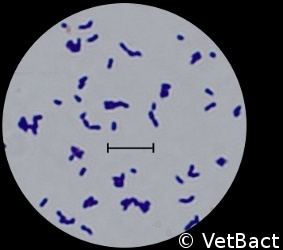Genus Trueperella Higher classification Trueperella | Scientific name Trueperella pyogenes Rank Species | |
 | ||
Similar Bacteria, Arcanobacterium haemolyticum, Fusobacterium necrophorum, Streptococcus uberis, Streptococcus dysgalactiae | ||
Trueperella pyogenes is a species of bacteria that are nonmotile, facultatively anaerobic, and gram-positive. The cells typically measure 0.5 by 2.0 μm. They appear as pleomorphic or coccoid rods. They tend to be grouped singly, or in short chains. Sometimes, they are grouped into V-shaped pairs.
T. pyogenes is found in the urogenital, gastrointestinal, and upper respiratory tracts of cattle, goats, horses, musk deer, pigs, and sheep, in which it may cause abscesses, mastitis, metritis, and pneumonia. It can thrive in either anaerobic or aerobic environments, but is ideally suited to one with high (about 7%) levels of carbon dioxide.
The species was originally classified as Actinomyces pyogenes, then Arcanobacterium pyogenes, now Trueperella pyogenes. When the genus Arcanobacterium was split into two (Arcanobacterium and Trueperella gen. nov.), the new genus name was chosen in honor of the German microbiologist Hans G. Trüper. The specific name pyogenes is used in various bacterial genera and was derived from the Greek word puon or Latin word pyum, and the suffix -genes, yielding pyogenes, meaning "pus-producing".
